WoRMS taxon details
Chrysaora quinquecirrha (Desor, 1848)
220476 (urn:lsid:marinespecies.org:taxname:220476)
accepted
Species
Dactylometra quinquecirrha Agassiz, 1862 · unaccepted
Pelagia quinquecirrha Desor, 1848 · unaccepted (synonym)
marine, brackish, fresh, terrestrial
recent only
(of Pelagia quinquecirrha Desor, 1848) Desor, E. (1848). No title. Meeting of the November 1, 1848. <em>Proceedings of the Boston Society of Natural History.</em> 3(1848 to 1851): 73–77 (Desor part pp. 75–76).
page(s): 76 [details]
page(s): 76 [details]
Type locality contained in Nantucket Sound
type locality contained in Nantucket Sound [from synonym] [view taxon] [details]
Distribution US Atlantic Coastal species
Description Width to 25 cm. Bell surface with fine warts. Four separate mouth-arms, up to 50 cm long, with frilled edges. Bell divided...
Distribution US Atlantic Coastal species [details]
Description Width to 25 cm. Bell surface with fine warts. Four separate mouth-arms, up to 50 cm long, with frilled edges. Bell divided...
Description Width to 25 cm. Bell surface with fine warts. Four separate mouth-arms, up to 50 cm long, with frilled edges. Bell divided into eight sections (octants); each octant with two notched, tongue-shaped lappets, three main tentacles and a minor one either side (thus five, hence the species name). Bell colour varies from transparent to bluish, pink, yellow or brown, maybe reddish streaked radially. Under-bell may be white; mouth arms pink to yellow with red speckles. Habitat: coastal. Distribution: Indo-Pacific, also Atlantic (Richmond, 1997). [details]
Collins, A.G.; Morandini, A.C. (2024). World List of Scyphozoa. Chrysaora quinquecirrha (Desor, 1848). Accessed through: World Register of Marine Species at: https://www.marinespecies.org/aphia.php?p=taxdetails&id=220476 on 2024-04-18
Date
action
by
![]() The webpage text is licensed under a Creative Commons Attribution 4.0 License
The webpage text is licensed under a Creative Commons Attribution 4.0 License
original description
(of Pelagia quinquecirrha Desor, 1848) Desor, E. (1848). No title. Meeting of the November 1, 1848. <em>Proceedings of the Boston Society of Natural History.</em> 3(1848 to 1851): 73–77 (Desor part pp. 75–76).
page(s): 76 [details]
basis of record Richmond, M. (Ed.) (1997). A guide to the seashores of Eastern Africa and the Western Indian Ocean islands. Sida/Department for Research Cooperation, SAREC: Stockholm, Sweden. ISBN 91-630-4594-X. 448 pp. (look up in IMIS) [details]
additional source F.S. Cornelius and J. van der Land (eds), updates 2000-2007, as a contribution to UNESCO-IOC Register of Marine Organisms (look up in IMIS) [details]
additional source Segura-Puertas, L., L. Celis, and L. Chiaverano. 2009. Medusozoans (Cnidaria: Cubozoa, Scyphozoa, and Hydrozoa) of the Gulf of Mexico, Pp. 369–379 in Felder, D.L. and D.K. Camp (eds.), Gulf of Mexico–Origins, Waters, and Biota. Biodiversity. Texas A&M Pre [details]
additional source Morandini AC, Marques AC. (2010). Revision of the genus <i>Chrysaora</i> Péron & Lesueur, 1810 (Cnidaria: Scyphozoa). <em>Zootaxa.</em> 2464: 1-97., available online at http://www.mapress.com/zootaxa/list/2010/2464.html [details]
redescription Bayha, K. M.; Collins, A. G.; Gaffney, P. M. (2017). Multigene phylogeny of the scyphozoan jellyfish family Pelagiidae reveals that the common U.S. Atlantic sea nettle comprises two distinct species (Chrysaora quinquecirrha and C. chesapeakei). <em>PeerJ.</em> 5: e3863., available online at https://peerj.com/articles/3863/ [details]
page(s): 76 [details]
basis of record Richmond, M. (Ed.) (1997). A guide to the seashores of Eastern Africa and the Western Indian Ocean islands. Sida/Department for Research Cooperation, SAREC: Stockholm, Sweden. ISBN 91-630-4594-X. 448 pp. (look up in IMIS) [details]
additional source F.S. Cornelius and J. van der Land (eds), updates 2000-2007, as a contribution to UNESCO-IOC Register of Marine Organisms (look up in IMIS) [details]
additional source Segura-Puertas, L., L. Celis, and L. Chiaverano. 2009. Medusozoans (Cnidaria: Cubozoa, Scyphozoa, and Hydrozoa) of the Gulf of Mexico, Pp. 369–379 in Felder, D.L. and D.K. Camp (eds.), Gulf of Mexico–Origins, Waters, and Biota. Biodiversity. Texas A&M Pre [details]
additional source Morandini AC, Marques AC. (2010). Revision of the genus <i>Chrysaora</i> Péron & Lesueur, 1810 (Cnidaria: Scyphozoa). <em>Zootaxa.</em> 2464: 1-97., available online at http://www.mapress.com/zootaxa/list/2010/2464.html [details]
redescription Bayha, K. M.; Collins, A. G.; Gaffney, P. M. (2017). Multigene phylogeny of the scyphozoan jellyfish family Pelagiidae reveals that the common U.S. Atlantic sea nettle comprises two distinct species (Chrysaora quinquecirrha and C. chesapeakei). <em>PeerJ.</em> 5: e3863., available online at https://peerj.com/articles/3863/ [details]
 Present
Present  Present in aphia/obis/gbif/idigbio
Present in aphia/obis/gbif/idigbio  Inaccurate
Inaccurate  Introduced: alien
Introduced: alien  Containing type locality
Containing type locality
From editor or global species database
Distribution US Atlantic Coastal species [details]From other sources
Description Width to 25 cm. Bell surface with fine warts. Four separate mouth-arms, up to 50 cm long, with frilled edges. Bell divided into eight sections (octants); each octant with two notched, tongue-shaped lappets, three main tentacles and a minor one either side (thus five, hence the species name). Bell colour varies from transparent to bluish, pink, yellow or brown, maybe reddish streaked radially. Under-bell may be white; mouth arms pink to yellow with red speckles. Habitat: coastal. Distribution: Indo-Pacific, also Atlantic (Richmond, 1997). [details]
| Language | Name | |
|---|---|---|
| English | US Atlantic Sea nettlesea nettleEast coast sea nettleAtlantic sea nettle | [details] |
| German | Seenessel | [details] |
| Russian | Хризаора пятищупальцевая | [details] |
To Barcode of Life (14 barcodes)
To Biodiversity Heritage Library (22 publications)
To Biodiversity Heritage Library (39 publications) (from synonym Dactylometra quinquecirrha Agassiz, 1862)
To European Nucleotide Archive (ENA)
To GenBank (4435 nucleotides; 67 proteins)
To Global Biotic Interactions (GloBI)
To NMNH Extant Collection (Dactylometra quinquecirrha) (from synonym Dactylometra quinquecirrha Agassiz, 1862)
To USNM Invertebrate Zoology Cnidaria Collection (146 records)
To USNM Invertebrate Zoology Cnidaria Collection (8 records) (from synonym Dactylometra quinquecirrha Agassiz, 1862)
To Yale Peabody Museum of Natural History (YPM IZ 101923)
To ITIS
To Biodiversity Heritage Library (22 publications)
To Biodiversity Heritage Library (39 publications) (from synonym Dactylometra quinquecirrha Agassiz, 1862)
To European Nucleotide Archive (ENA)
To GenBank (4435 nucleotides; 67 proteins)
To Global Biotic Interactions (GloBI)
To NMNH Extant Collection (Dactylometra quinquecirrha) (from synonym Dactylometra quinquecirrha Agassiz, 1862)
To USNM Invertebrate Zoology Cnidaria Collection (146 records)
To USNM Invertebrate Zoology Cnidaria Collection (8 records) (from synonym Dactylometra quinquecirrha Agassiz, 1862)
To Yale Peabody Museum of Natural History (YPM IZ 101923)
To ITIS
From other sources
Hosted externally, from synonym

